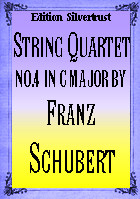Presents
Franz Schubert
 |
|
String Quartet No.4 in C Major, D.46
Franz Schubert (1797-1828), one of the most famous composers of all time, requires no introduction. However, his first six string quartets are virtually unknown and rarely heard let alone played. To learn more about their background and why that is Click Here.
There is no place better to hear the kind of experiments which Schubert was making than in the opening bars to String Quartet No.4, in C Major, D.46. Schubert, for the second time in four quartets, begins with an Adagio—not an entire movement, but an introduction, in and of itself, is both original and important. In 1813, there were virtually no precedents for beginning a quartet in this fashion, certainly not amongst the better known Viennese classicists, of which Schubert could have been awarewith one exception—Mozart’s K.465 ’Dissonant’ Quartet. There are a number of parallels, but also an important difference. Both quartets are in the key of C Major. The Adagio introductions to both works are introspective, even brooding in mood. One has the sense that something ominous is impending—especially in the Schubert where the bold use of chromaticism is quite striking. But this is as far as the similarity goes. In the Dissonant, there is suddenly sunshine, unexpected for sure and no more of the gloomy introduction. But in the Schubert, the Allegro which follows is indeed a stormy one. In addition, unlike Mozart, Schubert uses the theme of the introduction as part of the musical structure to the main movement. There is a lovely second theme which appears two times but only briefly. One is reminded of the last movement to the Third Quartet which was completed only one month before this work. The opening to the second movement, Andante con moto, begins in typical early Schubertian fashion with the first violin stating a simple pastoral melody to a pulsing accompaniment in the other voices, however, in the middle section, which at first appears to be a development of the main theme, he not only gives each voice part of the harmonic underpinning, but also uses the viola and its special timbre to achieve a mellow result. Sonata form is discarded and the main theme simply morphs into a march. Further, the main theme is never formally restated but appears only at the very end of the movement after an almost imperceptible transformation of the second theme. In the following Menuetto, Schubert begins with an ordinary and somewhat bombastic minuet but in the middle section, he creates a beautiful and rather haunting dance. This is done by dramatically reducing the dynamics to a mere hush while minutely shifting the harmony measure by measure. The trio provides an excellent contrast with the minuet. After a two measure trumpet fanfare in the lower three voices the first violin gives forth with what is a typically charming Austrian ländler. What is unusual about this trio is that Schubert uses the little trumpet fanfare, integrates it into the first theme, and creates and hybrid second theme. Immediately after the double bar, the first violin gives forth with the trumpet call but then adds a lovely bird-like refrain which is clearly related to the first theme of the trio. This is the identical technique which Schubert employed in the first movement and one senses Schubert’s intentional experimentation with form rather than some lack of familiarity with the classical rules of strict sonata form. The buoyant main theme of the finale, Allegro, and the supporting accompaniment successfully create a considerable excitement.
This work will not only please amateurs but could be used by professionals as a fresh substitute for a Haydn or Mozart quartet. Again, we are not only pleased to offer this quartet but also Quartet Nos. 4-6 as a book at a special price.
| (A) String Quartet No.4-Parts | $24.95 |
|
|
(B) String Quartet No.4-Parts & Score |
$31.95 |
|
| (C) String Quartet Nos.4-6-Parts | $64.95 |
|
| (C) String Quartet Nos.4-6-Parts & Score | $84.95 |
|